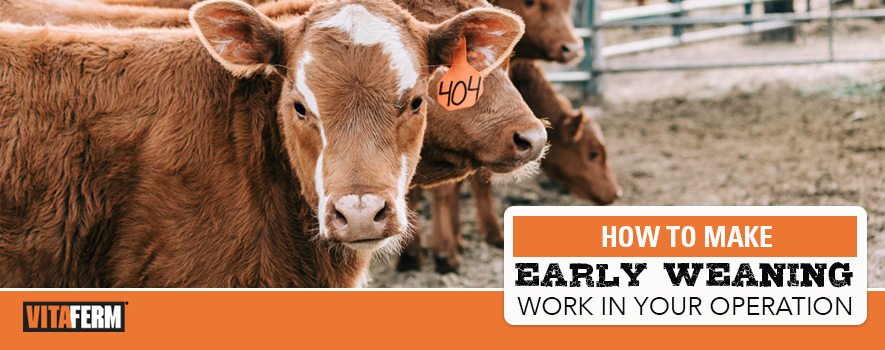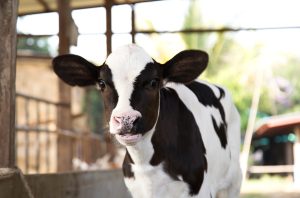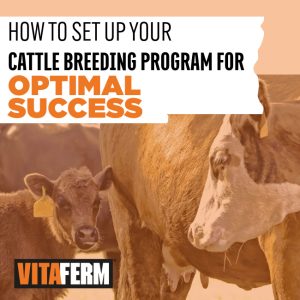
By Jack Oattes, M.S., BioZyme Inc.
The concept of early weaning in beef cattle has long been considered a management strategy that can potentially benefit cattle producers and their cow herds, although there are several considerations to make when deciding whether or not to implement this strategy. The goal of this article is to discuss some of the relevant historical research on the topic as well as point out some of the potential benefits and concerns that can be realized by implementing this strategy.
First of all, “early weaning” can vary greatly as there are many different management styles across the country. For the sake of this discussion, early weaning is considered anytime a producer weans calves earlier than their operation would typically do on a normal year, although historically, 205 days of age is considered standard for weaning age in beef cattle. If forage availability is limited, as is the case for many in the 2021 production year, removal of the calf from the side of the dam will improve performance for both the weaned calf as well as the dam, although the benefits of early weaning to the cow can be realized only if weaned calves can be successfully and economically raised with minimal facilities, labor and feed costs.
There have been countless research trials conducted to learn more about the dynamic nutrition of beef calves at the side of the dams. A trial conducted by Rutledge et al. (1971) indicated that approximately 60% of weaning weight variation in non-creep fed calves is the result of differing milk yields among dams. However, during the latter months of calf life, dam’s milk production plays a declining role in growth. In fact, Boggs et al. (1980) found that milk intake declined by 45% as a result of the normal lactation curve of the cow from birth to 6 months of age. However, in order for that calf to meet its nutrient requirements for growth it would have to consume other sources of nutrients. This is confirmed by Maddox (1965) who reported that by the time a calf is 3 months of age, greater than half of its energy is derived from sources other than milk. Therefore, it is reasonable to believe that it could be in a producer’s best interest to raise said calves by other means, which could ultimately prove to be more feasible depending upon feedstuff availability and pricing. Creep feeding grain has been extensively reviewed, as well as creep grazing and feeding calves in a dry lot situation utilizing a total mixed ration. Ultimately, local feedstuff availability and pricing is going to be the major driver as to what is the best choice of supplementation for each producer from an economic standpoint.
Performance benefits of early weaning to the calf are often seen as it is widely considered more efficient to feed a calf directly rather than feeding a cow to lactate and provide nutrition for a calf at side. Loy et al. (1999) conducted an experiment to evaluate early weaning at 60-70 days vs. 147 days using 120 steer calves sired by Angus or Simmental bulls to evaluate feedlot performance and carcass characteristics. Although early weaned calves entered the feedlot at heavier weights, weaning age had no effects on daily gain, dry matter intake, feed efficiency or harvest weights. Early weaned calves did however achieve a higher percentage of intramuscular fat relative to normal weaned steers (5.7% vs 5.1%), resulting in cattle that achieved more desirable quality grades with 38% USDA Choice or higher and 10% USDA Prime as compared to 14% USDA Choice or higher and 0% Prime for normally weaned steers.
Fluharty et al. (2000) evaluated the effects of weaning age on growth and carcass characteristics in steers over the course of two experiments. In their first experiment they utilized 78 Angus crossbred calves weaned at either 103 days or 203 days at which point they were transitioned onto finishing diets. In agreeance with several other studies on the topic, the early weaned group of calves had greater average daily gains from day 103 to day 203, allowing them to reach a final market weight 33 days sooner, part of which authors attributed the efficiency in conversion of feed to gain early in the feeding period. There were however no measurable differences in carcass characteristics. In the second experiment conducted by Fluharty et al. (2000), they utilized 64 Angus crossbred steers that were weaned at either 93 days or 210 days. Similar to their other findings, early weaned calves were heavier at the time of normal weaning (210 days), and early weaned calves also had greater backfat thickness at this time. This may be in part the reason authors noted frame size and genetics should be further analyzed to determine cattle that are best suited for early weaning especially when fed a high concentrate diet. These studies clearly show that early weaning can have a positive impact on calf performance and ultimately industry stakeholders at several levels of the beef value chain; from increased performance through the time that normal weaning age would occur to advantages in final carcass merit.
There is also research that demonstrates the benefits of early weaning to dams and potential carryover to the following production cycle. This improved cow performance can be characterized by improving reproductive efficiency if the weaning takes place before or during breeding season, as well as restoring body condition and body weight to the cow’s reserves.
Neville and McCormick (1981) evaluated the effects of weaning calves at 67 days of age or 230 days of age on dam performance. There were no reproduction differences between the two treatments in this particular trial, however dams of early weaned calves had 0.34 kg per day greater ADG than cows with a normal weaned calf. What is particularly interesting is that in the year following treatment, cows from the early weaned treatment calved 6 to 7 days later than dams from the normal wean treatment. Calves in year 2 resulting from dams that had been part of the early wean treatment also had higher 205-day weights than the progeny of dams that had weaned their calves normally in year 1. This suggests that perhaps there is an intrauterine effect on the fetus as a result of decreased nutrient requirement due to the cessation of lactation and increased dam performance.
Ultimately, the key to profitability for beef cattle producers is maximizing product output while optimizing cow herd inputs. Producers attempt to do this while maintaining cow herd body weight, body condition and reproductive efficiency. In order to achieve this, producers must ensure cow nutrient requirements are met while potentially also applying different management and nutritional strategies depending on environmental conditions. While early weaning is certainly a management consideration that can be effective for a lot of producers, additional supplementation can also be considered as a tool to maintain performance. Amaferm® is a prebiotic designed to enhance digestibility by amplifying the nutrient supply for maximum performance. It is research-proven to increase intake, digestion and absorption.


